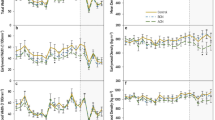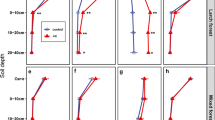Abstract
Nitrogen (N) deposition is a spatially and temporally heterogeneous process. Thus, the response to N deposition by plant communities can also be expected to vary in space and time. The total amount of deposition received by a plant community may vary regionally due to proximity to emission sources and locally due to vegetation structure. Temporal variation such as a seasonal peak in N deposition may coincide with specific life stages of the plant and drive community response to N deposition. Using the California oak savanna as a model ecosystem, a greenhouse experiment simulating realistic levels of N deposition received across the region was conducted to test the relative effects of N fertilization, soil type, light, and community mixture on the germination and seedling establishment of grasses. Seedling mixtures were composed of 3 common grass species—Stipa pulchra, Hordeum murinum, and Elymus caput-medusae—grown in monoculture and in 2- and 3-species combinations. Nitrogen fertilization alone had no effect on germination or seedling establishment, with one exception that high N increased seedling establishment of E. caput-medusae when that species was grown in monoculture. This limited effect of N deposition in a complex and realistic experimental setting indicated that deposition levels in oak savannas are not affecting most plants during early growth. Rather, early growth stages are species-specific and respond most strongly to neighbor identity.



Similar content being viewed by others
References
Abraham JK, Corbin JD, D’Antonio CM (2009) California native and exotic perennial grasses differ in their response to soil nitrogen, exotic annual grass density, and order of emergence. In: Van der Valk AG (ed) Herbaceous plant ecology. Springer, New York, pp 81–92. doi:10.1007/978-90-481-2798-6_7
Aerts R, Wallen B, Malmer N (1992) Growth-limiting nutrients in sphagnum-dominated bogs subject to low and high atmospheric nitrogen supply. J Ecol 80:131–140. doi:10.2307/2261070
Allen EB, Padgett PE, Bytnerowicz A, Minnich R (1998) Nitrogen deposition affects coastal sage vegetation of southern California. General Technical Report, Pacific Southwest Research Station, USDA Forest Service
Allen-Diaz B, Standiford R, Jackson RD (2007) Oak woodlands and forest. In: Barbour MG, Keeler-Wolf T, Schoenherr AA (eds) Terrestrial Vegetation of California. University of California Press, Berkeley, pp 313–338
Bartolome JW (1979) Germination and seedling establishment in California annual grassland. J Ecol 67:273–281. doi:10.2307/2259350
Belsky AJ (1994) Influences of trees on savanna productivity: tests of shade, nutrients, and tree-grass competition. Ecology 75:922–932
Belsky AJ, Mwonga SM, Amundson RG, Duxbury JM, Ali AR (1993) Comparative effects of isolated trees on their undercanopy environments in high-rainfall and low-rainfall savannas. J Appl Ecol 30:143–155
Bobbink R, Hornung M, Roelofs JGM (1998) The effects of air-borne nitrogen pollutants on species diversity in natural and semi-natural European vegetation. J Ecol 86:717–738. doi:10.1046/j.1365-2745.1998.8650717.x
Bytnerowicz A, Fenn ME (1996) Nitrogen deposition in California forests: a review. Environ Pollut 92:127–146. doi:10.1016/0269-7491(95)00106-9
Callaway RM, Nadkarni NM (1991) Seasonal patterns of nutrient deposition in a Quercus douglasii woodland in central California. Plant Soil 137:209–222
Clark CM, Tilman D (2008) Loss of plant species after chronic, low-level nitrogen deposition to prairie grasslands. Nature 451:712–715. doi:10.1038/nature06503
Cleland EE, Clark CM, Collins SL, Fargione JE, Gough L, Gross KL, Pennings SC, Suding KN (2011) Patterns of trait convergence and divergence among native and exotic species in herbaceous plant communities are not modified by nitrogen enrichment. J Ecol 99:1327–1338. doi:10.1111/j.1365-2745.2011.01860.x
D’Antonio CM, Malmstrom C, Reynolds SA, Gerlach J (2007) Ecology of invasive non-native species in California grassland. In: Stromberg MR, Corbin JD, D’Antonio CM (eds) California grassland: ecology and management. University of California Press, Berkeley, pp 67–83
Corbin JD, D'Antonio CM (2004) Can carbon addition increase competitiveness of native grasses? A case study from California. Restor Ecol 12:36-43. doi:10.1111/j.1061-2971.2004.00299.x
Draaijers GPJ, Ivens W, Bleuten W (1988) Atmospheric deposition in forest edges measured by monitoring canopy throughfall. Water Air Soil Pollut 42:129–136
Dukes JS, Chiarello NR, Loarie SR, Field CB (2011) Strong response of an invasive plant species (Centaurea solstitialis) to global environmental changes. Ecol Appl 21:1887–1894
Dyer AR, Fenech A, Rice KJ (2000) Accelerated seedling emergence in interspecific competitive neighbourhoods. Ecol Lett 3:523–529. doi:10.1046/j.1461-0248.2000.00187.x
Eviner VT, Firestone MK (2007) Mechanisms determining patterns of nutrient dynamics. In: Stromberg MR, Corbin JD, D’Antonio CM (eds) California grasslands: ecology and management. University of California Press, Berkeley, pp 94–106
Eviner VT, Chapin FS, Vaughn CE (2006) Seasonal variations in plant species effects on soil N and P dynamics. Ecology 87:974–986. doi:10.1890/0012-9658(2006)87[974:SVIPSE]2.0.CO;2
Fenn ME, Allen EB, Weiss SB, Jovan S, Geiser LH, Tonnesen GS, Johnson RF, Rao LE, Gimeno BS, Yuan F, Meixner T, Bytnerowicz A (2010) Nitrogen critical loads and management alternatives for N-impacted ecosystems in California. J Environ Manag 91:2404–2423. doi:10.1016/j.jenvman.2010.07.034
FRRAP (1988) California’s forests and rangelands: growing conflict over changing uses. Forest and Rangeland Resources Assessment Program. California Department of Forestry and Fire Protection
Gea-Izquierdo G, Gennet S, Bartolome JW (2007) Assessing plant-nutrient relationships in highly invaded Californian grasslands using non-normal probability distributions. Appl Veg Sci 10:337–343
Going BM, Hillerislambers J, Levine J (2009) Abiotic and biotic resistance to grass invasion in serpentine annual plant communities. Oecologia 159:839–847
Goldberg DE, Turkington R, Olsvig-Whittaker L, Dyer AR (2001) Density-dependence in an annual plant community: variation among life history stages. Ecol Monogr 71:423–446. doi:10.1890/0012-9615(2001)071[0423:DDIAAP]2.0.CO;2
Hamilton JG, Holzapfel C, Mahall BE (1999) Coexistence and interference competition between a native perennial and non-native annual grasses in California. Oecologia 121:518–526. doi:10.1007/s004420050958
Harpole WS, Potts DL, Suding KN (2007) Ecosystem responses to water and nitrogen amendment in a California grassland. Glob Chang Biol 13:2341–2348. doi:10.1111/j.1365-2486.2007.01447.x
Harpole S, Ngai JT, Cleland EE, Seabloom EW, Borer ET, Bracken MES, Elser JJ, Gruner DS, Hillebrand H, Shurin JB, Smith JE (2011) Nutrient co-limitation of primary producer communities. Ecol Lett 14:852–862. doi:10.1111/j.1461-0248.2011.01651.x
Herman DL, Halverson LJ, Firestone MK (2003) Nitrogen dynamics in an annual grassland: oak canopy, climate, and microbial population effects. Ecol Appl 13:593–604
Hoagland, Arnon DI (1950) The water-culture method for growing plants without soil. California Agricultural Experiment Station 347, College of Agriculture. University of California, Berkeley
Huenneke L, Hamburg SP, Koide R, Mooney HA, Vitousek PM (1990) Effects of soil resources on plant invasion and community structure in Californian serpentine grassland. Ecology 71:478–491
Jackson LE, Roy J (1986) Growth patterns of Mediterranean annual and perennial grasses under simulated rainfall regimes of southern France and California. Acta Oecol 7:191–212
Jackson LE, Potthoff M, Steenworth KL, O’Geen AT, Stromberg MR, Scow KM (2007) Soil biology and carbon sequestration in grasslands. In: Stromberg MR, Corbin JD, D’Antonio CM (eds) California grasslands: ecology and management. University of California Press, Berkeley, pp 107–118
Jones MB (1976) Fertility studies reveal plant and soil needs. Calif Agric 30:13–15
Jones MB, Vaughn CE, Williams WA (1995) Soil-phosphorous requirements for maximum growth of Northern California subclover-annual grass pastures. Commun Soil Sci Plant Anal 26:197–207. doi:10.1080/00103629509369290
Kellman M (1979) Soil enrichment by neotropical savanna trees. J Ecol 67:565–577. doi:10.2307/2259112
Kolb A, Alpert P (2003) Effects of nitrogen and salinity on growth and competition between a native grass and an invasive congener. Biol Invasion 5:229–238. doi:10.1023/A:1026185503777
Maron JL, Connors PG (1996) A native nitrogen-fixing shrub facilitates weed invasion. Oecologia 105:302–312. doi:10.1007/BF00328732
Martin WE (1958) Sulfur deficiency widespread in California soils. Calif Agric 12:10–12
National Atmospheric Deposition Program (NRSP-3) (2012) NADP Program Office, Illinois State Water Survey, 2204 Griffith Dr., Champaign, p 61820
Ochoa-Hueso R, Allen EB, Branquinho C, Cruz C, Dias T, Fenn ME, Manrique E, Perez-Colona ME, Sheppard LJ, Stock WD (2011) Nitrogen deposition effects on Mediterranean-type ecosystems: an ecological assessment. Environ Pollut 159:2265–2279. doi:10.1016/j.envpol.2010.12.019
Parker VT, Muller CH (1982) Vegetational and environmental changes beneath isolated live oak trees (Quercus agrifolia) in a California annual grassland. Am Midl Nat 107:69–81. doi:10.2307/2425189
Rice KJ, Nagy ES (2000) Oak canopy effects on the distribution patterns of two annual grasses: the role of competition and soil nutrients. Am J Bot 87:1699–1706. doi:10.2307/2656747
Schiffman PM (2007) Pleistocene and pre-European grassland ecosystems. In: Stromberg MR, Corbin JD, D’Antonio CM (eds) California grasslands: ecology and management. University of California Press, Berkeley, pp 37–86
Stahlheber KA, D’Antonio CM (2014) Do tree canopies enhance perennial grass restoration in California oak savannas? Restor Ecol 22:574–581. doi:10.1111/rec.12103
Stromberg MR, Griffin JR (1996) Long-term patterns in coastal California grasslands in relation to cultivation, gophers, and grazing. Ecol Appl 6:1189–1211. doi:10.2307/2269601
Thomsen MA, Corbin JD, D’Antonio CM (2006) The effect of soil nitrogen on competition between native and exotic perennial grasses from northern coastal California. Plant Ecol 186:23–35. doi:10.1007/s11258-006-9109-4
Tulloss EM, Cadenasso ML (2015) Nitrogen deposition across scales: hotspots and gradients in a savanna landscape. Ecosphere 6:167. doi:10.1890/ES14-00440.1
Tylianakis JM, Didham RK, Bascompte J, Wardle DA (2008) Global change and species interactions in terrestrial ecosystems. Ecol Lett 11:1351–1363. doi:10.1111/j.1461-0248.2008.01250.x
Vallano DM, Selmants PC, Zavaleta ES (2012) Simulated nitrogen deposition enhances the performance of an exotic grass relative to native serpentine grassland competitors. Plant Ecol 6:1015–1026. doi:10.1007/s11258-012-0061-1
Vitousek PM, Aber JD, Howarth RH, Likens GE, Matson PA, Schindler DW, Schlesinger WH, Tilman DG (1997) Human alteration of the global nitrogen cycle: sources and consequences. Ecol Appl 7:737–750. doi:10.2307/2269431
Vourlitis GL, Pasquini SC, Mustard R (2009) Effects of dry-season N input on the productivity and N storage of Mediterranean-Type Shrublands. Ecosystems 12:473–488
Weathers KC, Cadenasso ML, Pickett STA (2001) Forest edges as nutrient and pollutant concentrators: potential synergisms between fragmentation, forest canopies, and the atmosphere. Conserv Biol 15:1506–1514. doi:10.1046/j.1523-1739.2001.01090.x
Weiss S (1999) Cars, cows, and checkerspot butterflies: nitrogen deposition and management of nutrient poor grasslands for a threatened species. Conserv Biol 13:1476–1486. doi:10.1046/j.1523-1739.1999.98468.x
Young JA (1992) Ecology and management of Medusahead (Taeniatherum caput-medusae ssp. Asperum [Sink.] Melderis). Gt Basin Nat 52:245–252
Zavaleta ES, Shaw MR, Chiariello NR, Thomas BD, Cleland EE, Field CB, Mooney HA (2003) Grassland responses to three years of elevated temperature, CO2, precipitation, and N deposition. Ecol Monogr 73:585–604. doi:10.1890/02-4053
Acknowledgments
We thank Steven Silva at the UC Davis greenhouse facility, staff at research sites, and Cadenasso lab interns for their help and expertise in setting up and carrying out the experiment. We also thank Cadenasso lab members for helpful feedback and ideas about the manuscript. This project was funded through the Department of Plant Sciences and through a Jastro-Shields Scholarship from the College of Agriculture and Environmental Sciences at UC Davis. The manuscript has been improved by the insightful comments of Sarah Emery, Jeremy James and one anonymous reviewer.
Author information
Authors and Affiliations
Corresponding author
Additional information
Communicated by Sarah M. Emery.
Electronic supplementary material
Below is the link to the electronic supplementary material.
11258_2015_558_MOESM1_ESM.docx
ESM 1 Table comparing savanna sites and soils used in the experiment. Samples were collected both from understory and open grassland locations and averaged. Supplementary material 1 (DOCX 15 kb)
11258_2015_558_MOESM2_ESM.tif
ESM 2 Map and photos of three sites in California used to collect soil and seed for greenhouse experiment. From top-left: Hopland Research and Extension Center (HREC) in Mendocino County (38º58′57″N, 123º5′21″W), Sierra Foothills Research and Extension Center (SFREC) in Yuba County (39º15′9″N, 121º18′56″W), and San Joaquin Experimental Range (SJER) in Madera County (37º5′45″N, 119º43′45″W). Seed was collected from HREC only. Supplementary material 2 (TIFF 5245 kb)
11258_2015_558_MOESM3_ESM.docx
ESM 3 Table showing complete list of levels of the different factors used in the experiment. Supplementary material 3 (DOCX 13 kb)
Rights and permissions
About this article
Cite this article
Tulloss, E.M., Cadenasso, M.L. Using realistic nitrogen deposition levels to test the impact of deposition relative to other interacting factors on the germination and establishment of grasses in the California oak savanna. Plant Ecol 217, 43–55 (2016). https://doi.org/10.1007/s11258-015-0558-5
Received:
Accepted:
Published:
Issue Date:
DOI: https://doi.org/10.1007/s11258-015-0558-5




